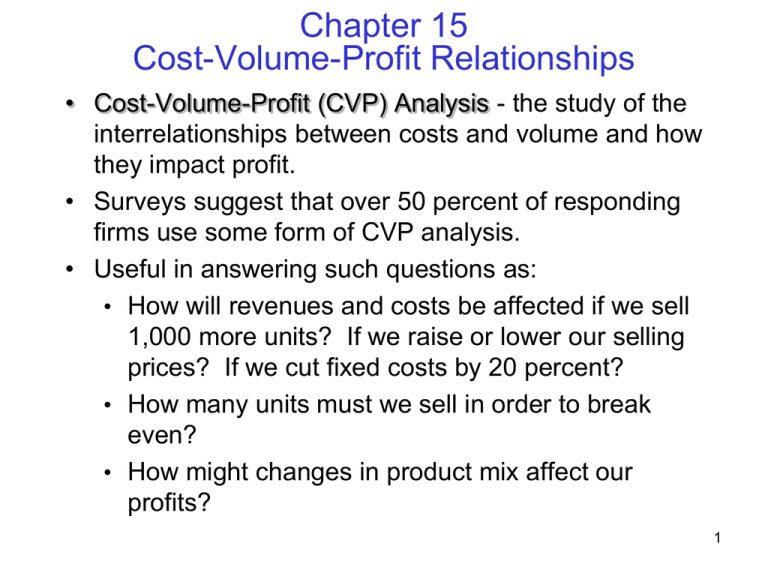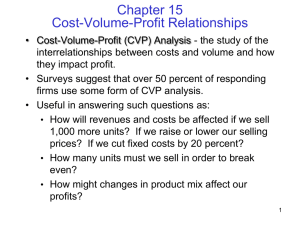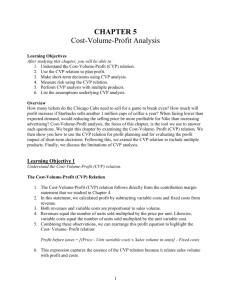Cost-Volume-Profit (CVP) Analysis
advertisement

Chapter 15 Cost-Volume-Profit Relationships • Cost-Volume-Profit (CVP) Analysis - the study of the interrelationships between costs and volume and how they impact profit. • Surveys suggest that over 50 percent of responding firms use some form of CVP analysis. • Useful in answering such questions as: • How will revenues and costs be affected if we sell 1,000 more units? If we raise or lower our selling prices? If we cut fixed costs by 20 percent? • How many units must we sell in order to break even? • How might changes in product mix affect our profits? 1 A New Income Statement Format • Traditional income statement mixes fixed and variable costs. • Examples – COGS has fixed and variable components. – Selling and administrative has fixed and variable components. • This has been the form we used in external financial reporting. • Your text calls this a functional income statement. • For internal analysis, we may restructure the income statement to arrange fixed and variable components into separate categories. 2 A New Income Statement Format The new format will be: Sales - Variable Costs = Contribution margin - Fixed Costs = Profit Note that all amounts above are total dollar amounts (as they are in the traditional income statement). We will abbreviate: S - VC = CM S - VC - FC = P 3 A New Income Statement Format The Contribution Margin activity may also be expressed in other formats: Per unit: Selling price per unit (SPU) Variable cost per unit (VCU) Contribution margin per unit (CMU) Percentage: where sales are defined as 100%, the VC and CM may be defined as a percentage of sales. Summary (note that Fixed Costs are always/only expressed in total): Dollars Per Unit Percentage Sales SPU 100% -VC -VCU - VC% =CM =CMU = CM% 4 “What-if” Decisions using CM Statement • Analyze the effect of changing various components: Selling price per unit Variable cost per unit Fixed costs • Changes in cost, price or volume usually affects other components as well. • CVP analysis examines the effects of these changes. 5 CVP Analysis CVP analysis arises from manipulation of the fundamental CM Income Statement: Sales - Variable Cost – Fixed Costs = Net Income Substitute “per unit” components, and indicate “X” as the number of units: SPU (X) - VCU (X) - FC = P (SPU – VCU) (X) CMU (X) CMU (X) = X = - FC = P - FC = P FC + P (FC + P)/CMU 6 Some Useful Formulas Target units to achieve a particular target profit (P): X = (FC + P) / CMU Target units required to break-even (target profit = 0): X = (FC + 0) / CMU For target revenues (sales activity in dollars) (1) take target units x selling price per unit, or (2) Substitute CM%(CM Ratio) for CMU in the above formulas when you do not know the units. 7 Graph of Break-Even $ Revenues Cost BE . Units Treatment of After-Tax Profit CVP analysis is based on before-tax profit, as tax laws have more effect than unit activity on cash paid for taxes. To convert from after-tax profit to before-tax profit, use the following formula: Before-tax Profit = After-tax Profit/(1- Tax Rate) One you have Before-tax Profit, just use it as “P” in all the formulas. 9 Operating Leverage • The extent to which a firm’s cost structure is made up of fixed costs is called operating leverage. • Everything else being equal, the higher a firm’s operating leverage, the higher its break-even point. • Higher leverage is associated with more rapidly increasing losses if demand is less than that required to break even. • Higher leverage is associated with more rapidly increasing profits after reaching the break-even point. • Firms with lower leverage tend to have greater flexibility in reacting to changes in demand. 10 Graph of Break-Even for High and Low Leverage Firms $ Revenues Lower Leverage Higher Leverage BE1 BE2 Intersection Units Operating Leverage • Operating leverage indicates the sensitivity of net operating income to percentage changes in sales. • Degree of operating leverage = Contribution margin in dollars Net operating income • This formula yields a factor change in income for every percentage change in sales. • Higher factor indicates a higher sensitivity to change in sales. • Higher factors "better" when sales go up, but more problematic when sales drop. 12 Example of Operating Leverage Given the following two companies: Company A Company B CM $120,000 CM $180,000 Fixed Cost 90,000 Fixed 150,000 Net Inc. $30,000 Net Inc. $ 30,000 Calculate operating leverage: Co. A Co. B CM/NI 120/30 = 4 180/30 =6 Interpretation: For A: 1% increase in sales = 4% increase in NI For B: 1% increase in sales = 6% increase in NI If sales increase 2%, NI : A incr. 2% x 4 = 8% x 30,000 = $2,400 B incr. 2% x 6 = 12% x 30,000 = $3,600 Class Problem Assume that a company is considering a change in its cost structure, and would like to automate some of its production activities. The current fixed costs are $60,000 per year and the current variable cost per unit is $20. This decision would add $42,000 per year to the fixed costs, but reduce variable cost per unit by $6 per unit (reduced labor costs). 1. Calculate the Break even for the current cost structure. 2. Calculate the Break Even in units if the new cost structure is implemented. 3. Calculate the point at which the new cost structure is more profitable than the old cost structure, i.e., at what point do the two cost functions intersect? Graph for Class Problem $ Revenues Part 1 Part 2 Units Multiple Products and Sales Mix • Sales mix is the relative proportion in which a company’s products are sold. • Changes in sales mix will cause a change in profit. • Changing to a high profit margin item may decrease sales revenue but increase profit. • Changing to a low profit margin item may increase sales revenue but decrease profit. • Changes in sales mix complicates the breakeven analysis. • Multiple products must be analyzed with a “weighted average” contribution margin, based on the proportional contribution if each product. 16






